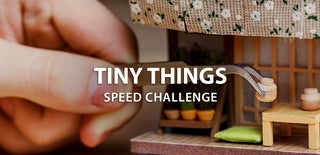Introduction: Christmas Tree With 555 Timer and CD4017 Decade Counter IC
Hey everyone what's up,
SO here's something really cool, a small Christmas tree-themed PCB powered by 555 timer ic and a CD4017 Decade counter.
The idea here was to make a simple Blinky Board that drives 10 LEDs in a blinky sequence or mode. LEDs are driven by CD4017 and 555 timer ic controls the decade counter's clock pin.
In this Instructables, I'm gonna show you guys how I made this PCB in a few easy steps.
Also, I made this setup as a soldering challenge kit, We solder all the THT components with a soldering iron and the end result will be a complete Blinky circuit that is themed after a cool-looking Christmas tree.
If you're interested in getting this kit for yourself, check out my Tindie page for more details.
Now without wasting any more time, let's get started.
Supplies
These are the stuff I used in this build-
- CUSTOM PCB x 1
- RGB LEDs 5mm (you could use normal LEDs here as well) x 10
- 100K Ohms resistance x 2
- 10K Ohms Resistance x 1
- SR206 Diode x 1
- 555 Timer IC x 1
- CD4017 x 1
- 22uF Capacitor x 1
- 100nf Capacitor x 1
- Breadboard x 1
- 12V Power source
Step 1: Basic Setup
To make a PCB-themed after a Christmas tree, I first searched for a Black and white design of a Christmas tree that I could import into my PCB Cad software.
The image that I used was in PNG format so first I edited this in PAINT and exported a BMP image as my PCB Cad Software only uses BMP Image.
BMP format is a standard format for importing image but other software include adding PNG so you can skip this converting process and import your image into the PCB Cad software.
how to do that?
Well in my OrCAD software, I have to make a logo file first and then add the image into this logo file, later then I can import the logo file into my PCB design. this process is long and your software probably can directly import the image so search around for any imported image option or just google how you can do that in your PCB cad software.
Also, This imported image will be placed as a TOP or BOTTOM silkscreen depending on your Board Layout, Try to place it in the Opposite layer of the THT Components.
Next, I prepared a simple 555 timer IC and CD4017 Setup with 10 LEDs, I prepared the schematic and then converted it into a Board file.
I Placed all the LEDs around the outer boundary on the TOP Layer, and all the components are placed on the BOTTOM Layer.
Art Part of this project will be visible from the front and at the backside, all the components are placed.
After finalizing the PCB, I exported its Gerber data and sent it to PCBWAY for samples.
Step 2: Getting PCBs From PCBWAY
I received PCBs in a week and the PCBs were nice as expected.
For this project, I choose Green Soldermask as I'm making a TREE here and Green color is the best option here. They also had MATTE GREEN Silkscreen which is an Option B.
I really like the quality of the white solder mask, also it was a tough job as the silkscreen that I have laid out on this board was not completely symmetrical but PCBWAY did an excellent job of manufacturing this PCB with no error whatsoever.
Also, They offer 3D Printing services along with a bunch of other stuff that includes Assembly Service, CNC service, Mould preparation, and many more.
PCBWay you guys rock, check out PCBWay service for getting great PCB service at less cost.
Step 3: ASSEMBLY PROCESS
Because this PCB doesn't have any SMD components. we don't have to do any fancy SMD process in this. I generally make PCBs with SMD Components that require a solder paste process and other things but we don't have to do that with THT components.
Step 4: ADDING COMPONENTS ON THE BOTTOM SIDE
First, on the Bottom Layer, we add components in their right place one by one. then we solder all the joints and remove the leg of resistance with a wire cutter and that is pretty much it.
Step 5: ADDING COMPONENTS ON THE TOPSIDE
We then do the same for the TOP Side, we add LEDs on their place and solder them one by one. then we remove their legs with a wire cutter and the circuit is finally ready.
Step 6: RESULT
Here's the result, Circuit is working.
You could swap the RGB LED with a normal 5mm LED of any color you like. because of the Decade counter, they will all work in a chasing sequence and the rate of chasing can be controlled by adjusting the value of R2 and R3 along with the Value of C1 that is connected to 555 timer ic.
Step 7: POWER SOURCE
As for the power source, I'm using a 12V SMPS here but you can use any voltage source between 5V-12V.
This is it for today guys, Thanks PCBWAY for supporting this project, Check out PCBWAY for getting all kinds of services at a very economical cost.
Stay safe and I'll be back with another project soon.
Peace!

Participated in the
Tiny Things Speed Challenge







![Tim's Mechanical Spider Leg [LU9685-20CU]](https://content.instructables.com/FFB/5R4I/LVKZ6G6R/FFB5R4ILVKZ6G6R.png?auto=webp&crop=1.2%3A1&frame=1&width=306)





